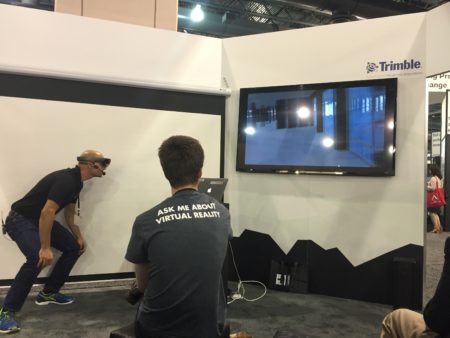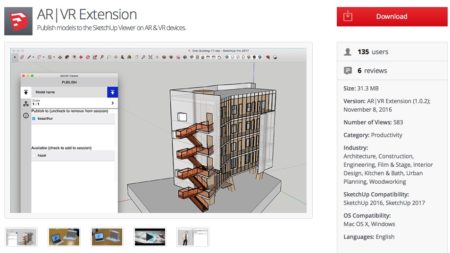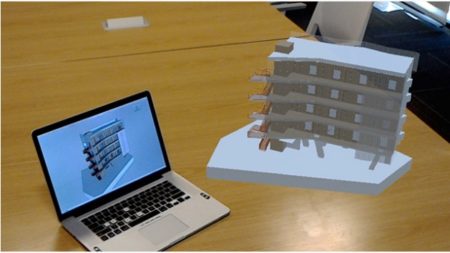A combination we awarded at AIA in our BEST of SHOW program earlier this year, Trimble officially this month announced the launch of its SketchUp Viewer for Microsoft Hololens. The new mix-reality (MR) tech combo offers some stunning capabilities that blend the virtues of VR and AR together.
Inhabit and Experience
Architect Greg Lynn, along with Microsoft and Trimble, made the announcement at the Trimble Dimensions event last week in Las Vegas. Lynn showed how the SketchUp Viewer for Hololens could improve design and construction processes. Using Hololens architects and designers can experience SketchUp models in a mixed reality—with holograms placed inside the real world.
The way this process works is a user wears a Hololens device, which is a type of goggles and is able to see 3D imagery projected in front of them. Beyond the edges of the imagery the user experiences everything, their eyes would typically see. More than one person can experience the technology at a time.

01 – The release of the award-winning Trimble SketchUp Viewer for Microsoft Hololens is now out. If you are already a SketchUp user, all you need is a Hololens.
Greg Lynn leveraged Trimble’s mixed-reality solution and Microsoft HoloLens to re-imagine the Packard Plant—a historic, abandoned automobile factory in Detroit. The architectural project was commissioned as part of the U.S. Pavilion at the 2016 Venice Biennale exhibition in Italy.
“Trimble mixed-reality technology and Microsoft HoloLens bring the design to life and bridge the gap between the digital and physical. Using this technology I can make decisions at the moment of inception, shorten the design cycle and improve communication with my clients,” said Greg Lynn.
Trimble’s mixed-reality solution gives users the ability to understand and communicate complex spatial conditions in one comprehensive and immersive experience.

02 – Back at AIA National 2016 in Philly, Architosh experienced this technology when the company said it was a late alpha. For a late alpha it was working pretty amazingly and it stole the show at the Trimble SketchUp booth.
“Empowering people to design and communicate better in 3D is part of our DNA. Across the SketchUp platform, we are dedicated to the idea that technology should get out of the way of our users,” said Chris Keating, general manager of Trimble’s SketchUp. “With SketchUp Viewer, we are taking another big step toward delivering the ultimate experience for designers and their clients—the experience of inhabiting their own work.”
World’s First HoloGraphic Computer
Microsoft HoloLens is the world’s first self-contained, holographic computer that provides a mixed-reality experience for a range of commercial and consumer applications. Architosh awarded the beta level software for Hololens by Trimble at the 2016 AIA National Convention with a “BEST of SHOW award” in the Emergent Technology category, for its innovative approach within the overall context of the VR/AR movement. Trimble SketchUp Viewer for Hololens offers the AEC industry thematic change for practice.
“We are thrilled to work with Trimble to deliver innovation to SketchUp, one of the most widely used applications in the architecture, engineering, construction, and operations industry,” said Lorraine Bardeen, general manager of Microsoft HoloLens and Windows Experiences. “SketchUp Viewer for Microsoft HoloLens can dramatically improve collaboration, decision making, efficiency, quality, and safety by giving users the unique ability to bring digital content into the real world, real-time as part of their current workflow.”
Using This Technology
In Tabletop, mode user can view models that have been “published” to their Hololens device via the newly launched AR/VR Extension for SketchUp Desktop. They can also browse and download models from Trimble 3D Warehouse, or they can pull project files down from Trimble Connect, a cloud-based collaboration platform that now shares the same 3D graphics pipeline (software engine) as the latest SketchUp desktop application. The user then has the option to place the model in their physical environment.

03 – Any SketchUp user can install the AR/VR Extension now and publish models for the Hololens device from the desktop — available for both macOS and Windows.
From within the application, you can choose to view your digital model in Hololens at 1:1 scale or another scale such as 1:5 or 1:20 or 1:50 if you are doing vast urban design for example. But 1:1 means you can literally “inhabit” your model as if actually there.
From within Hololens, the user can switch between Tabletop mode and Immersive mode, offering a mixed reality (MR) experience as described earlier. This enables the user to overlay digital models in real world environments and because Microsoft Hololens is an entirely untethered device the user can walk freely around the bounds of their physical environment (like a conference room, for example) as they inhabit their physical surrounds.
SketchUp Viewer for Hololens does more than just allow the user to immerse themselves into their digital models; the application allows the user to obtain vital project information by selecting model elements and using the Entity Info feature to get embedded BIM data from within project components. Also, the Tape Measure function gives users the ability to pull up dimensions from the model. The user can also toggle layers on and off to expose different aspects of the model, like removing exterior walls, or ceiling for example.

04 – In this image we see a user wearing a Microsoft Hololens while looking at their SketchUp model at a particular scale within the context of their physical surroundings which happen to show a MacBook running SketchUp with the model loaded.
Real-time, remote and co-located collaboration are key elements to the experiential design review process in SketchUp Viewer. With multiple HoloLens devices, a group of users can load the same model, engaging a “see what I see” collaboration mode. Remote collaborators can communicate via real-time audio and use mixed-reality visualization “sight-guides” to better understand who in the group is looking at what.
Availability
All the technology is available today. The first step is to buy a Microsoft Hololens, a self-contained, holographic computer. The Hololens device starts at $3,000.USD. You can purchase directly from Microsoft. The next step is to download the Trimble AR/VR Extension from Extension Warehouse. This is a free download, and the software extension runs on both macOS and Windows versions of SketchUp. Develop your SketchUp designs on your Mac, view them on your Hololens.



Reader Comments
Comments for this story are closed